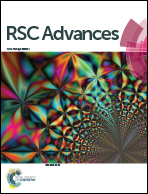Silver-catalyzed direct spirocyclization of alkynes with thiophenols: a simple and facile approach to 3-thioazaspiro[4,5]trienones†
Abstract
A new and convenient silver-catalyzed direct oxidative spirocyclization of alkynes with thiophenols is described. This methodology provides a simple and practical approach to various 3-thioazaspiro[4,5]trienones in moderate to good yields with high atom efficiency and excellent functional group tolerance.
![Graphical abstract: Silver-catalyzed direct spirocyclization of alkynes with thiophenols: a simple and facile approach to 3-thioazaspiro[4,5]trienones](/en/Image/Get?imageInfo.ImageType=GA&imageInfo.ImageIdentifier.ManuscriptID=C5RA16548B&imageInfo.ImageIdentifier.Year=2015)

 Please wait while we load your content...
Please wait while we load your content...